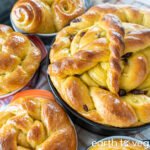
Vegan Paska (Eastern European Easter Bread)
Servings: 16 paskas
Calories: 349kcal
Cost: $0.20 per serving
Vegan paska is an enriched sweet bread eaten as part of Ukrainian Easter holiday tradition. Bursts with zesty orange flavour thanks to the use of whole oranges.
Print Recipe
Equipment
- Blender or food processor
- Stand mixer (with dough hook attachment)
- Bench scraper
- Loaf pan, cake pan, or ramekins
Ingredients
- 2 oranges (see Note 1)
- ¾ cup aquafaba
- 1 cup coconut milk (see Note 2)
- ½ cup butter, melted
- ¾ cup sugar
- 1 tsp salt
- 1 tbsp instant yeast
- 6½ to 7 cups bread flour or all purpose flour
- 1 cup raisins (*optional)
- 2 tbsp runny apricot jam or melted butter (*optional)
Instructions
- Rinse each orange thoroughly and cut into eight pieces. Remove any seeds or blemished skin, but keep the peels on.
- Add oranges, aquafaba or soyfaba, coconut milk, melted butter, sugar, and salt to a blender or food processor. Blend on high speed until smooth (it took me 40 seconds using a Vitamix).
- Pour the mixture into the bowl of a stand mixer. Scatter yeast over top, followed by 6½ cups of flour.
- Using the dough hook attachment, mix on medium-low speed (see Note 3). Once all the flour has been incorporated, continue kneading on medium-low speed for 12 minutes. Towards the end, the ball will start pulling away from the sides of the bowl, but it won’t fully form into a ball.
- Turn out the dough onto a lightly floured surface and shape into a ball. A bench scraper is very helpful for this step. It should be very soft and tacky, but if it’s too sticky to work with, add up to 1/2 cup of additional flour by sprinkling it over the dough and folding it in (see Note 4).
- Grease the bowl and put the dough ball back into the bowl. Cover with plastic wrap or a damp towel and let rise in a warm place for 1 to 1½ hours, or until doubled in size.
- Punch down the dough. No need to be gentle, get all the air out! If using raisins, fold them in now (see Video or Step-by-Step images for how to do this).
- Cut into 16, 8, 4, or 2 pieces depending on how big you want to bake your paska. Dividing the dough into 16 pieces will make baby paskas that can be baked in 8-oz ramekins. Dividing into 2 pieces will give you 2 full-sized loaves (baked in 9x5 inch loaf pans or 7-inch round cake pans). Or go for somewhere in between depending on the size of your baking vessels.
- Shape or braid each piece of dough as desired (see Video or Step-by-Step images to see how I shaped mine).
- Cover and let rise again for 45 minutes, until not quite doubled in size, but more like 1.5x in size. Meanwhile, preheat the oven to 375 °F.
- Bake anywhere from 25 minutes (for small breads, ie. 16 pieces) to 45 minutes (for full loaves, ie. 2 pieces). If the top is browning too quickly, cover with aluminum foil or use a big stainless steel bowl as a lid.
- Optional: Brush each paska with apricot jam or melted butter as soon as it comes out of the oven for a glossy coat.
Notes
- As with every baking recipe on this site, I strongly recommend weighing your ingredients. With something so variable in size like oranges, I can’t possibly guarantee your oranges are the same as mine. And everyone has a different technique for measuring flour—the New York Times found that a cup of flour can weigh anywhere from 4 to 6 oz depending on the scooping technique—so for the best possible results, please measure by weight.
- Full-fat coconut milk is recommended for best flavour. It also makes the dough softer and easier to work with than if you use lite coconut milk or substitute a different milk.
- Use the setting recommended by your mixer for kneading bread dough to avoid burning out the motor. On KitchenAid and Cuisinart models, this is Speed 2.
- Even if you weigh out your ingredients, you may find your dough is a bit stickier than expected due to factors like time of year (summer is typically more humid than winter), juicier oranges, different water absorption capacity of flour, etc… So if your dough is too sticky, then sprinkle on a bit more flour to make it more manageable. But try to add as little extra flour as possible. The higher the hydration of this bread, the better it tastes.
Nutrition
Calories: 349kcal | Carbohydrates: 60g | Protein: 8g | Fat: 9g | Saturated Fat: 4g | Polyunsaturated Fat: 2g | Monounsaturated Fat: 2g | Trans Fat: 0.03g | Sodium: 221mg | Potassium: 236mg | Fiber: 3g | Sugar: 13g | Vitamin A: 355IU | Vitamin C: 13mg | Calcium: 31mg | Iron: 1mg